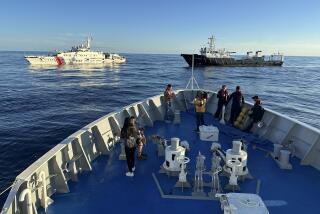U.S. Navy readies patrols near man-made Chinese islands
The Obama administration will soon order Navy warships to patrol near man-made islands constructed by China in the South China Sea, a U.S. warning that it will not accept Beijing’s vast territorial claims in the heavily traveled waters, officials said.
But a decision to escalate the tit-for-tat jockeying with Beijing carries risks: Depending on how the planned display of U.S. power unfolds, it could be seen by Beijing and American allies in the region as a sign of U.S. strength — or of a reluctance to confront China.
The Pentagon has given President Obama a menu of options that range from sending a lone, lightly armed vessel within the 12-mile territorial waters claimed by China around the dredged islands to a more formidable force of multiple warships and surveillance flights, an official familiar with the discussions said.
Although U.S. patrols within 12 miles of the islands in the Spratly archipelago are likely, officials say, Obama has not decided on how large a show of force he wants to make against China, a country with which the U.S. is keen to maintain smooth relations even as it seeks to counter Beijing’s growing assertiveness.
“Make no mistake, the U.S. will fly, sail or operate wherever international law allows, as we do around the world, and the South China Sea is not and will not be an exception,” Defense Secretary Ashton Carter told reporters Tuesday after he and Secretary of State John F. Kerry met with senior Australian officials in Boston.
NEWSLETTER: Get the day’s top headlines from Times Editor Davan Maharaj >>
Carter cited the “rising tensions” in the South China Sea and called for an end to reclamation projects in the area, but he avoided criticizing China directly and gave no indication of when the Pentagon might challenge Beijing’s territorial claims.
Adm. Harry Harris, who heads the U.S. Pacific Command, told reporters Friday that he had laid out multiple options for sending ships near the islands claimed by China.
“I’m comfortable knowing those options are being considered, and we’ll execute as directed” by Obama, Harris said, refusing to provide details.
After talks with Chinese President Xi Jinping at the White House last month, Obama vowed that the “United States will continue to sail, fly and operate anywhere international law allows.” Xi, for his part, insisted that China had no plans to militarize islands in the South China Sea.
Other Chinese officials have warned the country would not tolerate intrusions in its territorial waters.
“We will never allow any country to violate China’s territorial waters and airspace in the Spratly Islands, in the name of protecting freedom of navigation and overflight,” Chinese Foreign Ministry spokeswoman Hua Chunying told reporters Friday at a news briefing, according to Reuters.
The U.S. has long refused to take sides in territorial disputes in the South China Sea, where, along with China, nations such as the Philippines, Vietnam, Taiwan, Malaysia and others have multiple, sometimes overlapping claims.
Dredging by China in the last two years has built thousands of acres of new land on five coral outcrops in the Spratlys. On one, Fiery Cross Reef, China is building a 10,000-foot runway potentially usable by military warplanes.
But U.S. officials emphasize that man-made islands do not constitute sovereign territory under international law and therefore cannot be used to assert claims to territorial waters.
It’s rare for the Pentagon to telegraph in advance such a sensitive military move. The Navy conducts dozens of so-called freedom of navigation operations around the world every year, sending ships into disputed maritime areas, usually with no notice, to underscore U.S. claims that they are international waters.
In alerting Beijing that it is planning such an operation in the Spratlys, the U.S. may be hoping to lessen the chance of an inadvertent confrontation, analysts said.
However, it also gives Beijing time to position its own naval and coast guard forces in the vicinity so that it can shadow or potentially harass U.S. ships that cross the 12-mile line. The last time the U.S. patrolled near South China Sea island areas claimed by China was in 2012, before the reclamation projects began, officials said.
In May, a U.S. Navy P-8A Poseidon surveillance aircraft flew near Fiery Cross Reef but stayed outside the 12-mile limit. Even so, a Chinese military dispatcher demanded repeatedly that the airplane leave the area, warning that it was approaching a “military alert zone.”
The same month, a U.S. warship sailed through the Spratlys but also remained more than 12 miles away from China’s man-made islands. It was tailed but not interfered with by a Chinese navy vessel.
Last month, China sent five military ships into the Bering Sea off the coast of Alaska. At one point, U.S. officials said, the ships entered U.S. territorial waters, invoking a provision in maritime law that allows a warship to cross into another country’s maritime territory legally as long as the ships moved “expeditiously and continuously.”
The planned U.S. operation in the Spratlys is not comparable, in the U.S. view, because it asserts that the Chinese-claimed islands are in international waters.
Twitter: @davidcloudLAT
ALSO:
Use of force by border agents declines, but shootings remain steady
Police used Taser on Texas city councilman as he was kneeling on ground
Planned Parenthood stops taking reimbursement for fetal tissue procurements
More to Read
Start your day right
Sign up for Essential California for news, features and recommendations from the L.A. Times and beyond in your inbox six days a week.
You may occasionally receive promotional content from the Los Angeles Times.







